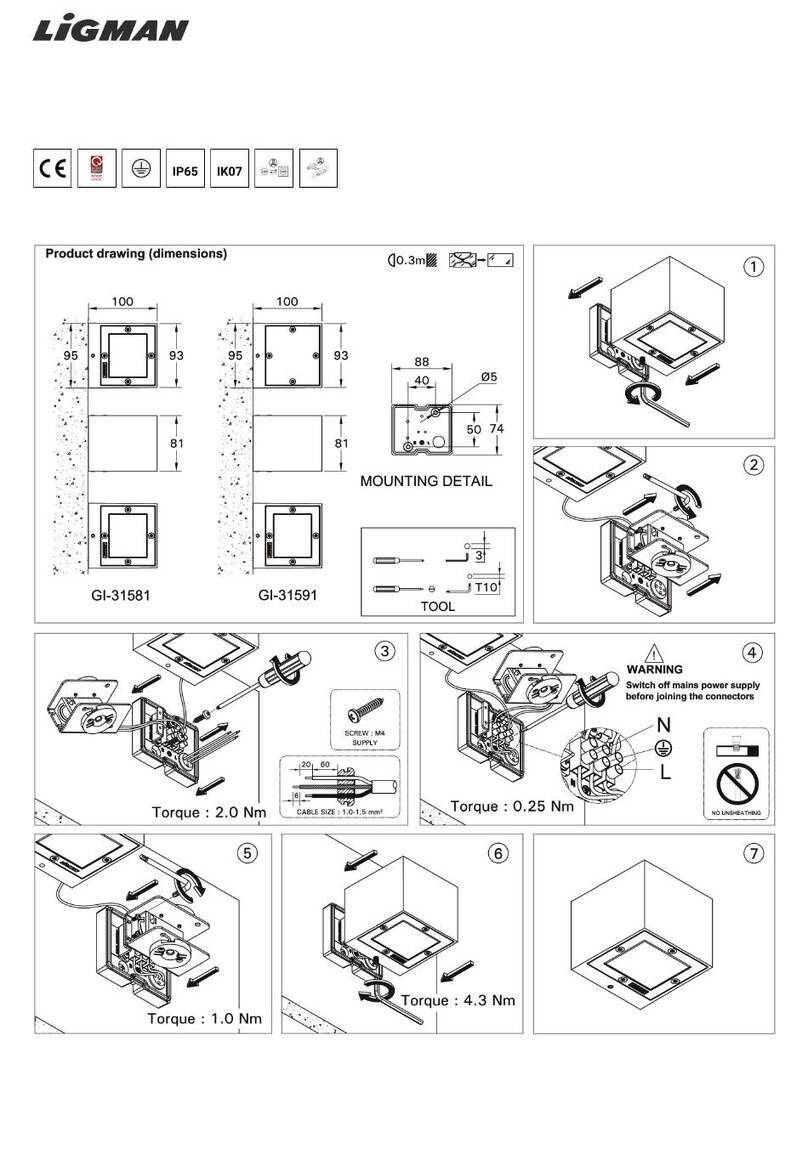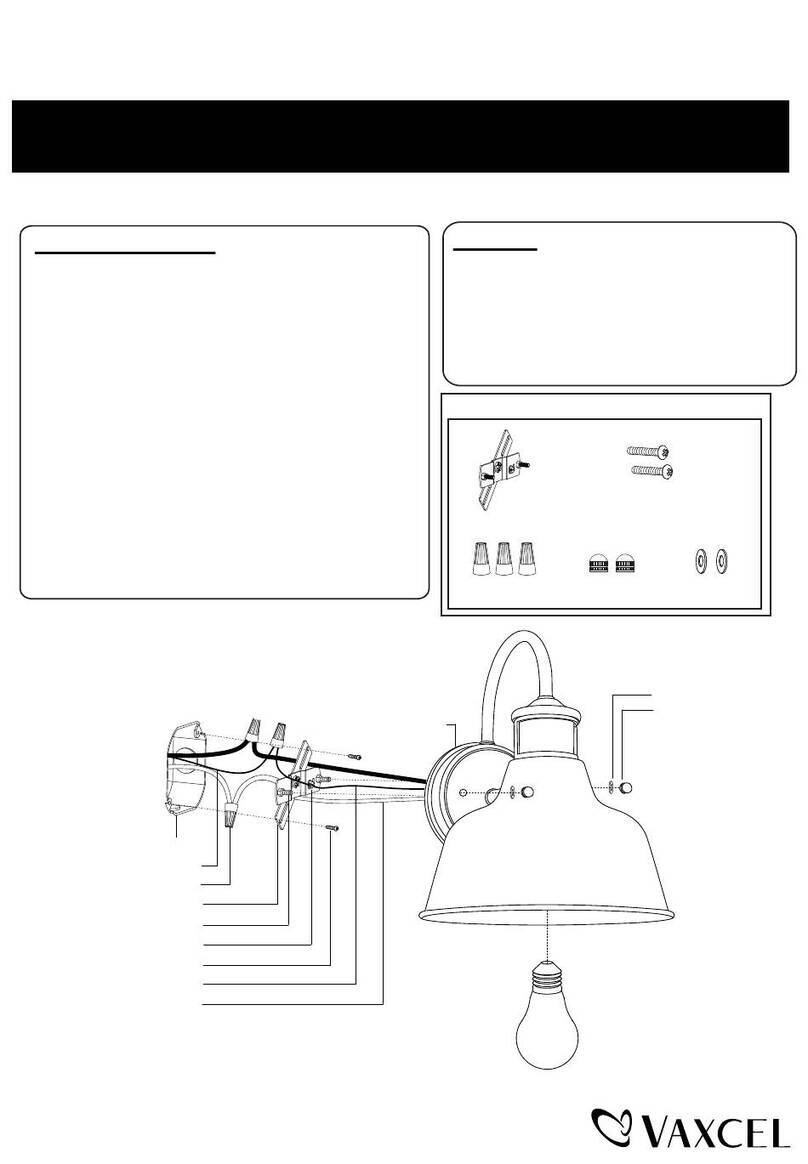Greengage ALIS CE User manual

4.37

Page 2of 28
Version 4.37 • CE • ALIS Tube Lamp
21 May 2019
ALIS Tube Coupler best practice clip on procedure
The new ALIS Tube Coupler has been designed with improved durability and ingress protection against dust and
high-pressure water jets. To ensure the longevity of the lamp it is important to follow the correct fixing procedure.
1. At the desired coupler position un-
twist, the ALIS-Bus by approximately
20cm (8”).
Undo the end clips by holding the lamp
and applying gentle pressure to the
hook part of the clip and pushing away
from the body of the lamp.
Excessive pressure may cause the clip
to come out of the hinge.
This is designed to happen as this
is a replaceable field part. If this
happens then simply push the clip back
into the hinge.
2. Undo the side clips by holding the
lamp firmly and applying equal pressure
with thumb to the clip, one corner at a
time.
3. Lift the upper coupler back on its
hinge and check the position of the
seal.
Due to the compression the seal may
have stuck to the upper coupler.
If this has occurred, then peel the seal
off and position it in the lower coupler
ensuring it has seated correctly.
4. Ensure the ALIS Bus is clean, free
from grit and undamaged.
Position the ALIS bus cable on the seal
in the lower coupler, ensure it is
correctly seated then push it firmly into
the guide clips.
5. Ensure that all the clips on the
coupler are fully disengaged before
closing the upper coupler.
Position the coupler lid squarely and
press down in place to ensure correct
fit.
6. Once correctly seated maintain firm
pressure clamping the couplers closed
before first closing the end clips.
7. To close the side clips, press firmly
with equal pressure both ends of
opposed clips to ensure the clips lock
into position securely.
8. To close the side clips, press firmly
with equal pressure both ends of
opposed clips to ensure the clips lock
into position securely.
9. Check that the four side clips are
completely closed.

Page 3of 28
Version 4.37 • CE • ALIS Tube Lamp
21 May 2019
Disclaimer
These instructions are provided for information purposes only.
Installation must be carried out by experienced/qualified professionals.
All electrical installation work must conform to all local and international electrical wiring and safety regulations
such as those published by CENELEC member organisations or those covered by IEC60364.
Greengage Lighting Ltd is not responsible for safety on site and installers should contact Greengage Lighting Ltd
technical support with any queries they may have at support@greengage.global
Please follow these instructions carefully as deviation from them may invalidate the product warranty.
Safety
Be safety conscious. Working with electrical circuits can be dangerous if you don’t take adequate safety precautions.
Always shut off the power to a circuit or device that you are working on.
Avoid wet areas when working with or on anything electrical.
If you are working on the service panel or a circuit, be sure to place a warning label on the face of the panel. This
will warn someone not to turn on the circuit that you are working on.

Page 4of 28
Version 4.37 • CE • ALIS Tube Lamp
21 May 2019
Contents
ALIS Tube Coupler best practice clip on procedure ................................................................................................ 2
Disclaimer........................................................................................................................................................... 3
Safety ............................................................................................................................................................... 3
Tools ............................................................................................................................................................... 5
Mounting accessories .......................................................................................................................................... 5
System description .............................................................................................................................................. 6
ALIS system components..................................................................................................................................... 6
For use only with parts as indicated ..................................................................................................................... 7
Installation procedures ........................................................................................................................................ 9
Introduction ............................................................................................................................................................................................. 9
1. Mechanical installation .................................................................................................................................... 9
1.0 General guidance................................................................................................................................................................................ 9
1.1 ALIS Bus Cable suspension.................................................................................................................................................................. 9
1.2 ALIS Power Hub mounting .................................................................................................................................................................. 9
1.3 ALIS Dimmer mounting..................................................................................................................................................................... 10
2. ALIS Tube connection (lengths 0.6, 0.9 & 1.2) ............................................................................................... 10
2.1 ALIS Tube Lamp coupler connection. ................................................................................................................................................. 11
3. Electrical installation section.......................................................................................................................... 11
3.0 General guidance.............................................................................................................................................................................. 11
3.1 ALIS bus termination ........................................................................................................................................................................ 12
3.2 End termination................................................................................................................................................................................ 13
3.3 End termination rules........................................................................................................................................................................ 14
3.4 Hub supply cable termination (CE)..................................................................................................................................................... 15
3.5 Hub supply cable termination (UL)..................................................................................................................................................... 15
3.6 System connection............................................................................................................................................................................ 15
4. Installation checklist and system test ............................................................................................................. 16
5. Fault finding................................................................................................................................................. 17
5.1 Led Status Indicator & Reset Button. ................................................................................................................................................. 17
5.2 Fault finding guide ............................................................................................................................................................................ 18
6. General points and good practices................................................................................................................. 19
7. Specifications ............................................................................................................................................... 20
7.1 ALIS Power Hub electrical ................................................................................................................................................................. 20
7.2 ALIS Power Hub environmental ......................................................................................................................................................... 20
7.3 ALIS Dimmer 230VAC ....................................................................................................................................................................... 21
7.4 ALIS Tube specifications ................................................................................................................................................................... 21
8. Compliance ................................................................................................................................................... 22
8.1 ALIS Power Hub 230VAC (CE) ........................................................................................................................................................... 22
8.2 ALIS Tubes (CE) ............................................................................................................................................................................... 23
Warranty validation ........................................................................................................................................... 24
Site Information ................................................................................................................................................................................. 24
Installer Information ......................................................................................................................................................................... 24
Install Information.................................................................................................................................................................................. 25
Appendix .......................................................................................................................................................... 26
Connection diagram................................................................................................................................................................................ 26
Assembly instruction – P2M connector supply ..................................................................................................... 27

Page 5of 28
Version 4.37 • CE • ALIS Tube Lamp
21 May 2019
Tools
Below is a list of basic tools necessary for carrying out your installation.
Other tools may be required depending on the exact suspension, mounting method used and the composition of
the surface mounting material.
Tape Measure
Screwdrivers including terminal driver
Cable cutters, crimpers and wire
strippers
Pliers
Multi Meter
Light Meter
Mounting accessories
Catenary cable
Twist Buckle
Cable ties
Eye hook
Suspension chain
Wire rope clamps

Page 6of 28
Version 4.37 • CE • ALIS Tube Lamp
21 May 2019
System description
The Greengage induction system (ALIS) is a 'contactless' power technology that allows fixtures (ALIS Tube
Couplers) to be clipped onto the cable (ALIS Bus) to provide power without an actual physical electrical
connection which can to then be used to power LED units (ALIS Tubes).
It works on the principle of distributing a highly regulated alternating current at 50 kHz along the ALIS Bus to the
ALIS Tube Couplers and ALIS Tubes.
This document serves as guidance for an ALIS installation within an intensive livestock rearing building. Installers
must also follow all applicable local electrical installation standards and wiring regulations when carrying out the
installation.
ALIS system components
ALIS is shipped as component parts for assembly on site. There is an option to purchase a pre-configured Power
Hub panel ready for direct install.
The main components of the ALIS system are
1ALIS Power Hub
2ALIS Dimmer
3ALIS Bus
4ALIS Tube Coupler
5End Termination Module
6ALIS Pot (dimmer control input)
7ALIS Tube
8ALIS Tube End Connector
9ALIS Tube Extension Cable
(optional)
Note: For further connection detail please see appendix connection diagram.

Page 7of 28
Version 4.37 • CE • ALIS Tube Lamp
21 May 2019
For use only with parts as indicated
Component parts
Model
CE
Model
cULus
Additional UL
Requirements/Use
1. ALIS Power
Hub
2. (500W)
IPH500230
IPH500110
Install only in dry
locations.
(or suitable enclosure to
meet local regulations)
3. ALIS Bus
ALS0018
(available in
500m reels)
ALS0035
(available in
1000m
reels)
Type USE-2 cable or Type
RHH-2 wire marked VW-
1.14AWG standard type
rated 90 C min and 300V
minimum.
4. ALIS Tube
Lamps 0.6m,
0.9m, 1.2m
ALS0013
ALS0012
ALS0011
Suitable for wet location
use. Do not submerse.
(IP66)
5. ALIS Tube
Coupler
ALS00015
ALS00015
Suitable for wet location
use. Do not submerse.
(IP66)
6. ALIS Tube
Extension
Cable
0.3m
ALIS0038
ALIS0038
Suitable for wet location
use. Do not submerse.
(IP66)
7. ALIS Tube
Extension
Cable
0.5m
ALS0039
ALIS0038
Suitable for wet location
use. Do not submerse.
(IP66)
8. ALIS Tube
End Connector
ALS0004
ALS0004
Suitable for wet location
use.
Do not submerse.
(IP66)
9. ALIS
Potentiometer
ALS0007
ALS0007
Install only in dry
locations.
(or suitable enclosure to
meet local regulations)

Page 8of 28
Version 4.37 • CE • ALIS Tube Lamp
21 May 2019
Component parts
Model
CE
Model
cULus
Additional UL
Requirements/Use
10. ALIS Dimmer
component
ALIS Dimmer
Plastic
Enclosure Kit
Assembly
ALIS Dimmer
in Plastic
Enclosure
IPD1230
ALS0040
ALS0045
IPD1110
ALS0040
ALS0046
Install only in dry
locations.
(or suitable enclosure to
meet local regulations)
11. ALIS Bus End
termination
module and
enclosure
ETM
ETM
Must be housed within a
suitably sealed enclosure
(IP66) see section 3.2
12. P2M Supply
Connector
P2M
N/A
Not applicable
CE Only
(requires suitable
enclosure to meet local
regulations)
13. ALIS IEC13
Power to
Mains
Connector
N/A
IEC13
Install only in dry
locations.
(or suitable enclosure to
meet local regulations)
14. ALIS Power
Hub Panel
ALS0006
(2 x 500W)
ALS0010
(1 x 500W)
Not
available in
North
America.
Not applicable
CE Only
15. DTD
Controller
ALS0049
ALS0049

Page 9of 28
Version 4.37 • CE • ALIS Tube Lamp
21 May 2019
Installation procedures
Introduction
This installation procedures section is divided in three parts; mechanical, lamp connection and electrical. These
require two distinct levels of technical competency. Here the mechanical and lamp sections are classified as semi-
skilled, i.e. suitable for most agricultural mechanical fitters, whilst the electrical section is classified skilled, i.e. only
suitable for competent and qualified electricians and fitters with experience and knowledge of local electrical
wiring standards and regulations.
1. Mechanical installation
1.0 General guidance
In this section you will find all the necessary information for the mechanical installation. This is the process
of physically fitting the components within the building. During this process no electrical connections are made.
The importance of correct mechanical fitting from the start should not be underestimated
as it can be very difficult, costly and at times impossible to correct afterwards. It is therefore
worthwhile discussing the mechanical fitting at an early stage with either the house builder
or architect to ensure that correct placement of the ALIS lamps within the house is possible.
If not, a redesign of the lighting plan may be required.
1.1 ALIS Bus Cable suspension
Reference the lamp positioning information found within the lighting design plan. It is recommended that the ALIS
Bus cable is supported by cable ties to a catenary wire, or other carrier type, which is itself supported every three
to four metres (10 to 13 feet) and tensioned by use of a turnbuckle also ensuring that the supporting infrastructure
is sufficient to support the lamps and suspension.
As the ALIS system works inductively it is important to avoid sharp bends, returns, kinks and knots in the ALIS Bus
cable. Excess cable should be removed and certainly not be coiled or wrapped especially around metal elements.
1.2 ALIS Power Hub mounting
The ALIS Power Hub must be mounted vertically on a metal base plate within a suitable enclosure in close proximity
to the ALIS Dimmer, away from all combustible materials, sources of heat and out of direct sunlight. Clearances of
100mm (4 inches) from the top and bottom of the ALIS Power Hub and 75mm (3 inches) from the sides must be
allowed for. Please contact support@greengage.global if this is not possible.

Page 10 of 28
Version 4.37 • CE • ALIS Tube Lamp
21 May 2019
1.3 ALIS Dimmer mounting
The ALIS Dimmer must be mounted within the same enclosure as the ALIS Power Hub, either horizontally or
vertically in close proximity to the ALIS Power Hub. If this is not possible then the ALIS Dimmer enclosure must
be used, mounted away from all combustible materials, sources of heat and out of direct sunlight.
ALIS Power Hub Panel
2 Channel x 500W
ALIS Dimmer
in enclosure
ALIS Power Hub Panels
(shown with DTD Controller providing 0-10V input)
Please note: Diagrams above for illustration purposes.
Both the ALIS Power Hub and ALIS Dimmer must be mounted within a dry and dust free
location acceptable to local wiring regulations. If this is not possible then they must be
housed within a suitably sealed enclosure as per local wiring regulations. Due to the heat
generated by the ALIS Power Hub please contact support@greengage.global for further
advice if required.
2. ALIS Tube connection (lengths 0.6m, 0.9m and 1.2m)
Reference the lamp positioning information, found within the lighting design plan in conjunction with section 5.0
of this manual. If there is not any positioning information available, then contact your supplier for further advice.
Take note of the lamp position and place the first ALIS Tube as follows.
1. Clip the first ALIS Tube onto the catenary wire carrier utilising the two channels provided at either end.
Place a fixing clip over each channel of the ALIS Tube to hold it in place.

Page 11 of 28
Version 4.37 • CE • ALIS Tube Lamp
21 May 2019
2. At this point further ALIS Tubes may be mounted and connected together, either directly joined or via the
0.3m or 0.5m connection cables as the design dictates, by mating the two connector halves and twisting
the outer nut. Note a maximum of 3.6m of ALIS Tube length of various size combinations may be
connected together to an ALIS Tube Coupler.
3. After deciding which free end of the ALIS Tube is best suited, connect the ALIS Tube coupler cable to that
end and an ALIS End Connector to the other as described in 2 above.
Depict close-up of tubes with coupler and end connector in place.
2.1 ALIS Tube Lamp coupler connection.
At the desired ALIS Tube Coupler position un-twist, the ALIS-Bus by approximately 20cm by inserting your thumbs
in the twist and sliding left and right equally. Fully open the ALIS Tube Coupler and place the ALIS-Bus into the
ALIS Tube Coupler housing as shown below, ensuring the ALIS-Bus is clean and free from grit. Press the ALIS-
Bus firmly within the guide clip channels. Note If this information places the ALIS Tube Coupler near an
obstruction such as a system partition, ensure the ALIS Tube Coupler is moved to at least 15cm from this point to
allow movement during washout.
Once positioned within the Coupler Housing, bring the two lid sections together and close. Caution Ensure that
the ALIS Bus is not trapped when closing the Coupler and the ALIS-Tube Coupler ferrite surfaces are clean and
free from grit. Note Ensure a minimum 3cm of ALIS-Bus remains untwisted at the Coupler entry holes. Too tight
a twist at this point can cause a lift in the Coupler lid resulting in a broken seal.
Attach all the remaining ALIS Tube Lamps to the desired position along the ALIS-Bus. Once completed cable tie
the ALIS-Bus to the catenary wire. Note Place the first two cable ties a minimum of 20 cm each side of the ALIS
Coupler ensuring the catenary wire supports the ALIS-Tube Coupler on its clip. Add the remainder of the cable ties
between 30cm to 40cm apart to ensure the ALIS-Bus does not droop at any point.
3. Electrical installation section
3.0 General guidance
In this section you will find all the necessary information for the electrical installation. This is the process
of electrically connecting the components within the livestock building construction. Each of the components
of the system will be handled in a separate paragraph. Please also reference section 6. of this manual.

Page 12 of 28
Version 4.37 • CE • ALIS Tube Lamp
21 May 2019
3.1 ALIS bus termination
Route the ALIS Bus to the ALIS Power Hub location, paying attention to the section 6. of this manual.
ALIS Dimmer Model IPDI110. Strip the ends of the ALIS Bus to 5mm (0.2 inch) of exposed conductor,
ensuring there is not any conductor loss.
Attach the ALIS Bus to the Bus Connector into the screw terminals provided, as shown below. Ensure there are
no frayed copper strands.
ALIS Dimmer Model IPDI230. Strip the ends of the ALIS Bus to 5mm (0.2 inch) of exposed conductor,
ensuring there is not any conductor loss.
Attach the ALIS Bus to the Bus Connector into the screw terminals provided, as shown below. Ensure there are
no frayed copper strands.
Note: The cable must be connected to the pin 1 and 2.
ALIS Dimmer Model AGL0004. Strip the outer insulation of the ALIS Bus to 30mm (1¼inches) taking care not
to damage the inner insulation. Strip the ends of the ALIS Bus inner insulation to 8mm (0.3 inch) of exposed
conductor, ensuring there is not any conductor loss.
Slide the orange connector cover labelled PLUG over the ALIS Bus. Attach the ALIS Bus to the orange connector
PLUG into the screw terminals provided, as shown below. Ensure there are no frayed copper strands. Slide and
fix the cover in place over the connector.
Remove the existing ALIS Bus connector from the ALIS Power Hub and cut off the remaining exposed copper
conductor. Slide the orange connector cover labelled SOCKET over the ALIS Power Hub ALIS Bus. Strip the outer
insulation of the ALIS Bus to 30mm (1¼ inches) taking care not to damage the inner insulation. Strip the ends of
the ALIS Bus inner insulation to 8mm (0.3 inch) of exposed conductor, ensuring there is not any conductor loss.
Attach the ALIS Power Hub ALIS Bus to the orange connector SOCKET into the screw terminals provided, as shown
below. Ensure there are no frayed copper strands. Side and fix cover in place over the connector.

Page 13 of 28
Version 4.37 • CE • ALIS Tube Lamp
21 May 2019
3.2 End termination
All ALIS Dimmer Models. The correct termination of the ALIS BUS is critical to the overall system performance.
See also section 3.3 of this manual. Connect the ALIS End Termination Module (ETM) or shorting terminal block
to the far open end of the ALIS Bus. The ALIS bus insulation must be properly stripped to ensure there is no to
damage the cable conductors.
Strip the ends of the ALIS Bus to 5mm (0.2 inch) of exposed conductor, ensuring there is not any conductor loss
as shown below. Twist the exposed copper cable strands.
Insert the cable into the terminator fully, ensuring no bare cable can be seen as shown and tighten connections.
This must be a perfect connection with no frayed copper strands. The ETM or short must be housed within an
IP66 terminal enclosure, example below.
A. ETM (68nF) ALIS Bus connection
B. Short ALIS Bus connection
Note: All cable points must have glands fitted for strain relief and to maintained IP rating.

Page 14 of 28
Version 4.37 • CE • ALIS Tube Lamp
21 May 2019
3.3 End termination rules
The ALIS systems works on an induction principle with lamps powered by a modulated AC waveform on the ALIS
Bus. To ensure optimal performance, the ALIS Bus needs to be kept in resonance with the output of the ALIS
Power Hub. As the length of the ALIS Bus and number of lamps increases its impedance changes and with that its
resonance frequency.
An ALIS Bus and coupler/tube combination which is out of resonance can cause of the ALIS Power Hub to trip and
require a manual reset and may also reduce the operational life of the ALIS Power Hub.
To ensure optimum operation and stability of the system, the following recommendations should be observed.
If the length of the ALIS bus is less than 100m then the ALIS Bus must be terminated by means of a shorting
connection to keep the ALIS Bus in resonance with the Hub.
When the length is greater than 100m, the ALIS Bus must be terminated using the supplied ETM (68nF) to keep
the ALIS Bus in resonance with the Hub.
Cable Length
Termination
≤100m
Short
101m to 150m
ETM (68nF)
>150m
Contact support@greengage.global
For continuous use it is recommended to have a minimum load >50W (or 6 ALIS Tube
Couplers with 3.6m of ALIS Tubes connected to each) on even a length of cable using a
short termination.
Model
Version
Cable
Length
(m)
Cable
Length
(feet)
Max
continuous
Load (W)
Max
surge
Power
(W)
Cable
Loss
(W)
Remaining
Power for
Tubes (W)
Max no.
ALIS Tube
Couplers
(10W)
ALIS
Power
Hub
500W
230VAC
(CE)
≤100
≤328
475
500
12
463
46
101-
150
329-
492
475 500 18 457 45
>150
>492
Contact support@greengage.global

Page 15 of 28
Version 4.37 • CE • ALIS Tube Lamp
21 May 2019
3.4 Hub supply cable termination (CE)
Connect the P2M Connector to a 3-core adequately rated mains supply cable by inserting into the screw terminals
as shown below. Ensure there are no frayed copper strands and the supply is adequately protected to meet all
local wiring regulations. Not applicable if installing a Greengage Power Hub Panel.
Note: For assembly instructions of P2M connector see appendix: Assembly instruction – P2M
connector supply.
3.5 Hub supply cable termination (UL)
Connect the IEC C13 Connector to a 3-core adequately rated mains supply cable by inserting into the screw
terminals as shown below. Ensure there are no frayed copper strands and the supply is adequately protected to
meet all local wiring regulations.
3.6 System connection
a. Connect the ALIS Bus to the ALIS Dimmer as shown in the ALIS system components diagram (page 5).
b. Connect the ALIS Dimmer to the ALIS Power Hub as shown in the ALIS system components diagram
(page 5).
c. Connect the selected dimming control method to the ALIS Dimmer. Dimming is possible via either an ALIS
Dimmer Pot or a 0-10VDC control signal, ensuring polarity is maintained, as shown in the ALIS system
components diagram (page 5).
Connecting ALIS Dimmer to ALIS Pot/0-10VDC (Not applicable if installing the Greengage Power Hub Panel).
Connectors of the same shape can be connected.
Multiple ALIS Dimmers can be controlled with a single ALIS Pot, Greengage DTD
Controller or another 0-10VDC supply.
The potentiometer connection to the hub can also be used to extinguish the lamps via the
use of a timer switch or on/off switch, which avoids the necessity of disconnecting the
mains supply.
Please contact support@greengage.global for additional information as required.
Blue
Yellow/Green
Brown

Page 16 of 28
Version 4.37 • CE • ALIS Tube Lamp
21 May 2019
4. Installation checklist and system test
After the successful installation of the ALIS system onsite, the following checks must be carried out by a qualified
electrician, adhering to local standards and regulations, prior to applying power to the system.
1. Double check the ALIS Bus cable length connected to the ALIS Power Hub. This should not exceed 150 metres.
If in doubt contact support@greengage.global
2. Count the number of ALIS Couplers and Lengths of ALIS Tubes per ALIS Bus per ALIS Power Hub. This should
ideally not exceed 40 x 10W ALIS Tube Couplers (see also section 3.3) or 3.6m of ALIS Tubes per ALIS Tube
Coupler. If in doubt contact support@greengage.global
3. Check each chain of ALIS Tubes are connected to each other, an ALIS Tube Couplers and an ALIS Tube End
Connector.
4. Check the ALIS ETM termination. Ensure the ALIS Bus cable is properly terminated.
5. Ensure the ALIS Dimmer is properly connected to the ALIS Bus.
6. Ensure the ALIS Dimmer is properly connected to the ALIS Power Hub.
7. Ensure the control cable (ALIS Dimmer Pot or independent 0-10VDc screened analogue voltage cable)
is properly connected to the ALIS Dimmer.
8. Connect mains power cable to the ALIS Power Hub
Once these points have been positively verified, power can then be applied to the ALIS system.
Please ensure that there are no open circuits within the ALIS Bus cable installation. This can be achieved by
ensuring all the connections of the Bus cable are correctly terminated.
If a problem is encountered, then we suggest a multi-meter is used to check continuity between the two cables at
the hub end. Please remove the ETM and join ALIS Bus to test. Ensure the ETM is reconnected after completing
the continuity test.
The 230VAC supply must be disconnected before continuity
testing is attempted.

Page 17 of 28
Version 4.37 • CE • ALIS Tube Lamp
21 May 2019
5. Fault finding
If the ALIS-Lamps flash ON and OFF, this means you have too much load on the system. Start unclipping the
ALIS-Tube Couplers one at a time until the flashing stops.
5.1 Led Status Indicator & Reset Button.
To facilitate fault diagnosis, the PH500/200 has a bi-colour (red & green) status indicator.
When the Power Hub is performing normally the status indicator is solid GREEN. If another indication is observed,
please see the chart below for an indication. To remove the fault, press the reset button as shown below by the
red arrow.
LED Status Indicator
Operating Mode
Description
Action
Steady Amber
Input voltage too low. Automatic lockout
when input supply
drops below 160 Vac
The ALIS-Hub resets when supply
returns to normal.
Flashing amber, 1
Flash per second, 50%
Duty cycle
Input voltage too high. Automatic lockout
when input supply
exceeds 270 Vac
The ALIS-Hub resets when supply
returns to normal.
Flashing alternate red
and green, 2 flashes
per second 50% duty
cycle.
Power required exceeds power
available.
Too much load fitted
to the ALIS-Bus
Remove excess load. The system
automatically resumes normal mode of
operation
Solid red
(with system OFF)
Output voltage too high. ALIS-Bus is
open circuit.
Repair fault in the ALIS-Bus. Reset the
system by pressing the reset button.
Solid red
(with system OFF)
ALIS-Hub only. Ground fault
protection.
ALIS-Hub has detected
a power imbalance in
the output current
(residual current)
>80mA rms
Disconnect from AC supply until LED is
extinguished. Examine the ALIS-Bus for
possible earth leakage. Reset button will
not allow re-start.
Flashes red, 1 flash
per second, 50%
duty cycle
Temperature too high. ALIS-Hub case
temperature exceeds
90˚C (+/-5˚C),
shutting itself down.
The ALIS-Hub resets when temperature
returns to normal. This may take
several minutes.
The reset button on the power hub can only be pressed 3 times. Thereafter the power
hub must be reset by disconnecting it from the AC mains supply, waiting until the status
indicator has extinguished and then reconnecting it.

Page 18 of 28
Version 4.37 • CE • ALIS Tube Lamp
21 May 2019
5.2 Fault finding guide
1. Firstly, ascertain what is or isn’t happening with the system. There are commonly two scenarios.
ALIS Tube(s) are completely extinguished.
ALIS Tube(s) are flashing or flickering.
2. Once i or ii has been ascertained the next step is to find the reason.
3. ALIS Tube (s) are completely extinguished. If there is just one or more, but not all, ALIS Tubes extinguished,
first check their through connection(s) to the associated ALIS Tube Coupler and ALIS Tube End Connector.
If these are OK open the associated ALIS Tube Coupler and remove it from the ALIS Bus at the same time
inspecting the cable for damage. Check the ALIS Tube Coupler is free of contaminates and if required clean with
a soft cloth. If the ALIS Bus is OK refit the ALIS Tube Coupler. If the problem has not been resolved replace the
ALIS Tube Coupler or problem ALIS Tube.
4. If all ALIS Tube s are extinguished continue as follows.
i. Check the ALIS Hub status LED as described on page 9 and attempt to resolve the problem by carrying
out the listed actions.
If the ALIS Hub status LED is showing a steady green light, and a competent person is present, bypass the ALIS
dimmer by first disconnecting the 230VAC supply to the ALIS Hub, disconnect the ALIS Dimmer from the ALIS Hub
and ALIS Bus and connect the ALIS Hub directly to the ALIS Bus, reconnect the 230VAC supply to the ALIS Hub.
This will confirm whether the ALIS Dimmer has a problem.
If the status LED is completely extinguished check there is an adequate mains supply present. Once the correct
supply voltage level is ascertained attempt a power up reset. If this does not resolve the fault replace the power
hub, firstly carrying out the check list on page 8.
5. ALIS Tube(s) flashing or flickering. If this is the observed fault, then in all probability the ALIS hub is not the
problem. Firstly, ascertain whether it is a few ALIS Tubes or all the ALIS Tubes on the ALIS Bus, if it is
continuous or only occurs at certain times of day. Has it only just started to happen?
ii. If there are only a few of the ALIS Tubes showing fault symptoms, then in all likelihood it is a local
problem to those ALIS Tubes and ALIS Tube Couplers. First check the through connection(s) to the
associated ALIS Tube Coupler and ALIS Tube End Connector. If these are OK open the ALIS Tube Coupler
and remove it from the ALIS Bus at the same time inspecting the cable for damage. Check the ALIS Tube
Coupler is free of contaminates and if required clean with a soft cloth. If the ALIS Bus is OK refit the ALIS
Tube Coupler. If the problem has not been resolved replace the ALIS Tube Coupler or problem ALIS Tube.
iii. If it is all the ALIS Tubes on the ALIS Bus and the ALIS Hub shows no signs of fault, then it is most
probably an external issue such as electrical noise which can be very difficult to pin point. Firstly, try to
ascertain if there have been any changes in the immediate area such as new equipment installed or any
cable rerouting. As a process of elimination try to locate the problem item by switching off other
equipment. As this is a process of elimination a considerably amount of time may be required, but in the
end, it should be easily remedied.
If any problems or faults occur that are outside any of the above or you are having difficulties, please do not
hesitate to contact support@greengage.global further guidance.

Page 19 of 28
Version 4.37 • CE • ALIS Tube Lamp
21 May 2019
6. General points and good practices
1. All electrical installation work must be carried out in accordance with all applicable local wiring regulations,
such as those published by CENELEC member organisations, or those covered by IEC60364. Failure to do so will
invalidate any associated Product Warranty.
2. The ALIS Power Hub or Power Hub Panel must be earthed/grounded via a securely wired electrical connection.
It is not sufficient to rely solely on the bonded chassis alone.
3. Ensure that all external cables are of a suitable cross-sectional diameter for the intended use. All external signals
carrying cable for uses such as 0/10v must be of a suitably screened/shielded type, with the screen/shield
connected to earth at the supply end only, neverboth ends.
4. For the connection of external wires always use insulated ‘bootlace’ terminals, which provide a safe and good
connection, and which are well suited for the purpose.
5. Splices and cable joints must be housed within a junction box, which has an IP rating suitable for the
environment. All cables must pass through suitable glands to maintain the rating.
6. Never use solid communication style wires such as telephone cable, even if making low voltage/current
connections, it is not suitable for any of the connectors within the ALIS range and will in time fail.
7. Cable trunking and conduit. In certain instances, ALIS Bus cable may have to be routed through lidded electrical
wire carriers. Should this situation arise please ensure that all ends are sealed, and lids correctly fitted to stop
fauna (rodent) ingress.
8. Installations should never use no more than the required length of ALIS Bus for each ALIS Power Hub. Remove
any excess end of line ALIS Bus cable at approximately 30cm (12 inches) past the final lamp.
9. ALIS Bus cable should never be knotted or looped. it is also important to avoid sharp bends, returns,
and kinks. The minimum recommended bend diameter is 75mm (3 inches).
10. Please note that poorly made electrical connections are often the main cause of equipment failure, which
in turn leads to livestock fatalities.
11. If the ALIS Bus passes through a hole or aperture (metal or otherwise) a suitable insulating grommet or gland
must be fitted.
12. ALIS Bus cable should never be un-twisted, apart from through the lamp coupler.
13. Under no circumstances must the ALIS Bus be switched by any means, be that relay, contactor, isolator
or circuit breaker, unless parts are supplied by Greengage Lighting for that purpose. If this is attempted the
subsequent damage caused to the ALIS Power Hub will be irreparable and will not be covered by any Product
Warranty.
14. Disconnecting the main electrical supply to the ALIS Power Hub as a means of regularly extinguishing the ALIS
Lamps must always be avoided.
15. If switching the 0/10V control signal, the selection of the switching component is extremely important, please
adhere to the instructions on the relevant circuit diagram, obtainable from support@greengage.global
Contact degradation can lead to the situation, particularly at low current levels, where the switching device
operates mechanically but effectively remains open circuit causing the ALIS lamps to remain at full brilliance.
.

Page 20 of 28
Version 4.37 • CE • ALIS Tube Lamp
21 May 2019
7. Specifications
7.1 ALIS Power Hub electrical
7.1.1 Input Specifications 230VAC (CE)
Parameter
Description
Minimum
Nominal
Maximum
VAC RMS
Input Supply
198
230
264
Frequency
AC RMS (Hz)
47
50
60
AC Start Up
Input Start Voltage (V)
178
180
182
AC Shut Down
Input Stop Voltage (V)
157
159
161
Current
Current RMS (A)
-
-
3.7
Insulation information:
Secondary output circuit of IPH500 is separated from its Primary input circuit by basic insulation; Control circuit
(SELV) is separated from Primary/Secondary circuits by reinforced insulation.
7.1.3 Output Specifications 230VAC (CE)
Parameter
Description
Minimum
Nominal
Maximum
Power Rating 230VAC (CE)
Max Power
-
-
500W
Load Regulation
0-500W Output
+/- 0.95%
+/- 1.45%
+/- 1.95%
O/P Frequency
ALIS Bus
49 kHz
50 kHz
51 kHz
O/P Current
ALIS Bus
1.805A
1.9A
1.995A
Start Time
Turn On Time
460mS
480mS
500mS
475W output rating is only guaranteed for US mains supplies. The 475W rating must be
de-rated to maximum 425W for supplies below 100 VAC.Voltage
7.2 ALIS Power Hub environmental
Parameter
Description
Minimum
Nominal
Maximum
Operating Temperature
Thermal Environment
-40˚C
25˚C
40˚C
Non-operating Temperature
Thermal Environment
-40˚C
-
70˚C
Storage Temperature
ALIS Bus
-40˚C
-
100˚C
Operating Humidity
Non-condensing
0%
-
85%
Non-operating Humidity
Non-condensing
0%
-
95%
Operating Altitude Maximum
3,000m or 10,000 feet
Non-operating Altitude Max
15,000m or 50,000 feet
Enclosure rating. Indoor use
IP10 or NEMA Type 1.
95% RH is achieved with a dry bulb temperature of 55˚C and a wet bulb temperature
of 54˚C.
This manual suits for next models
1
Table of contents
Popular Outdoor Light manuals by other brands
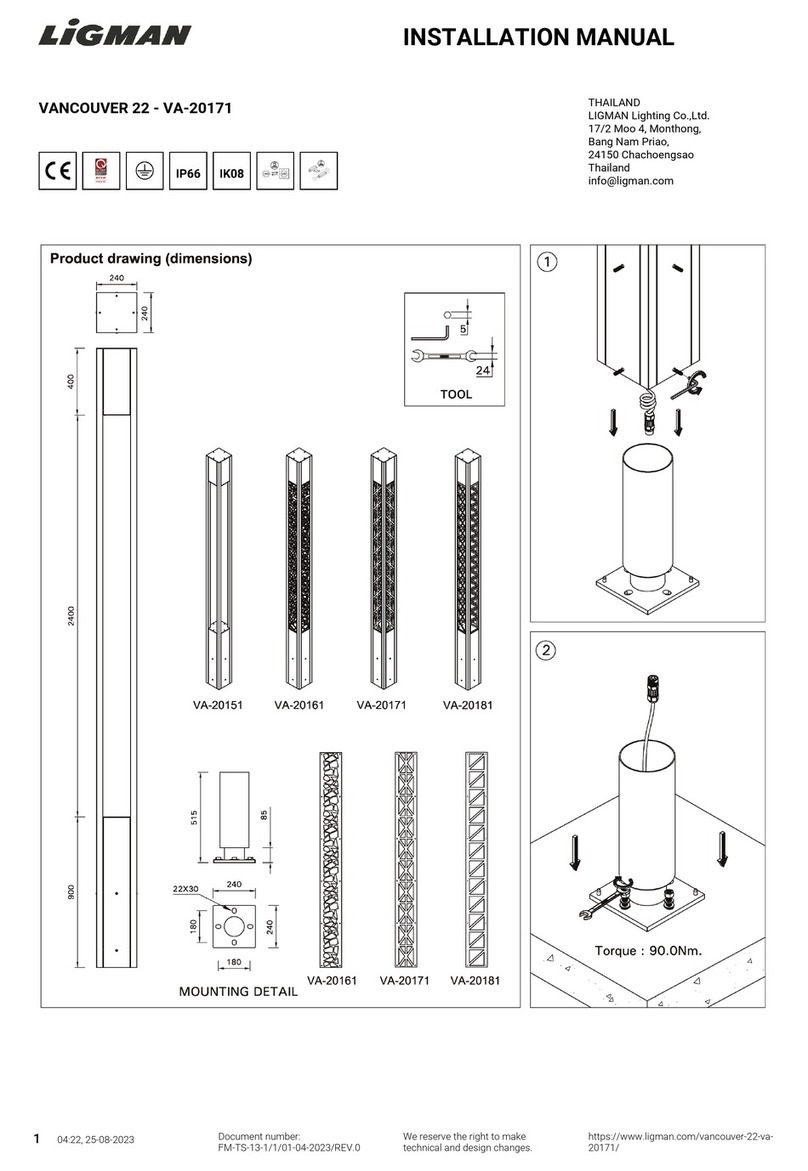
LIGMAN
LIGMAN VANCOUVER 22 installation manual
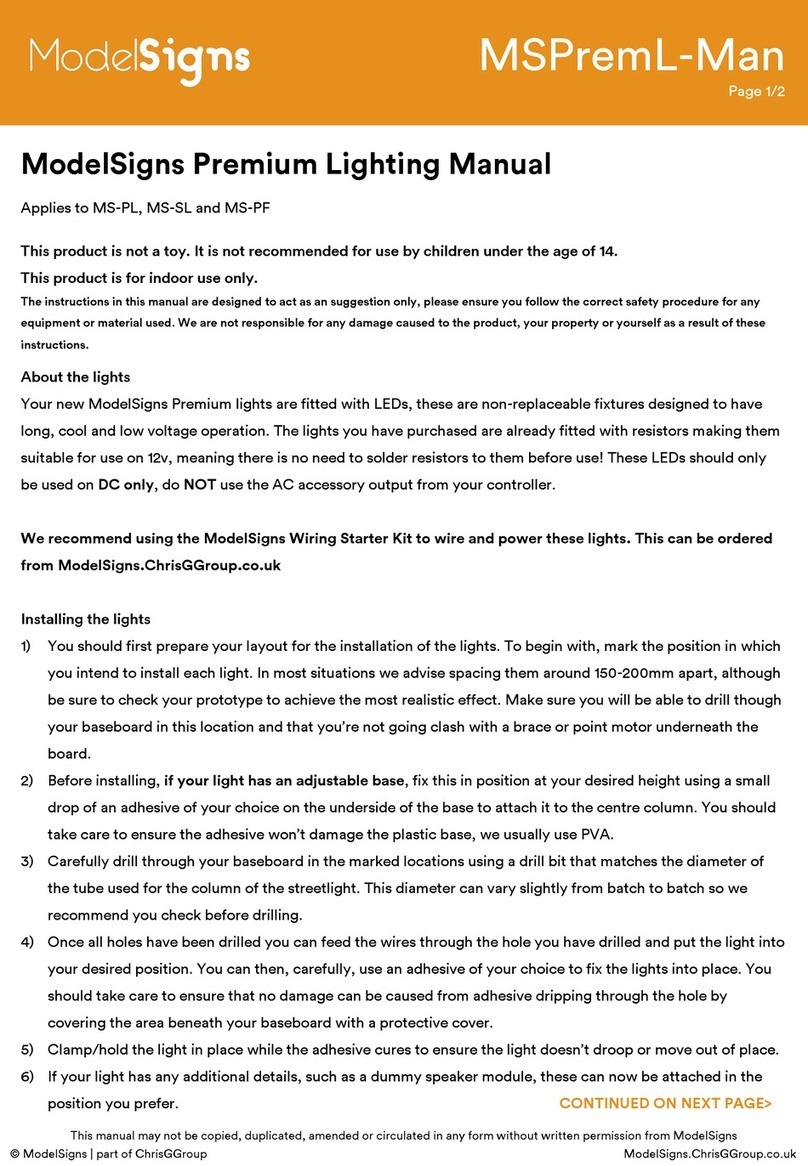
ModelSigns
ModelSigns MS-PL manual
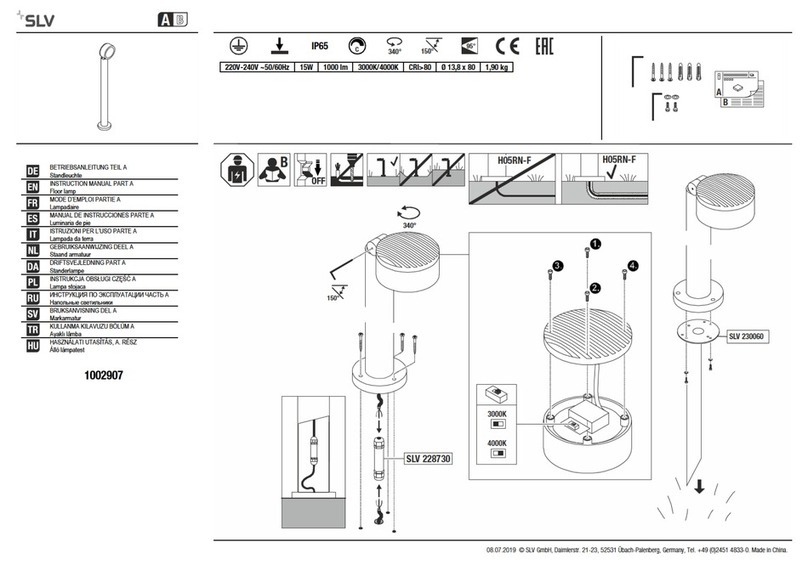
SLV
SLV ESKINA 1002907 instruction manual
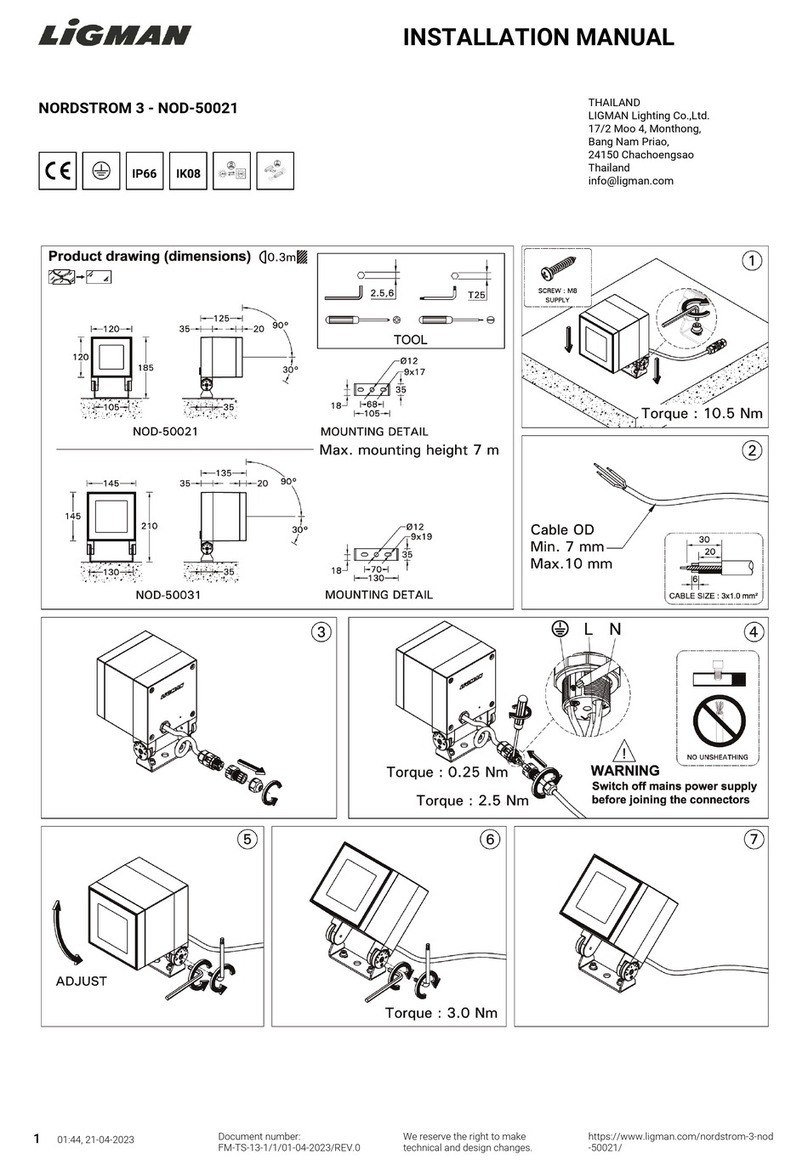
LIGMAN
LIGMAN NORDSTROM 3 NOD-50021 installation manual
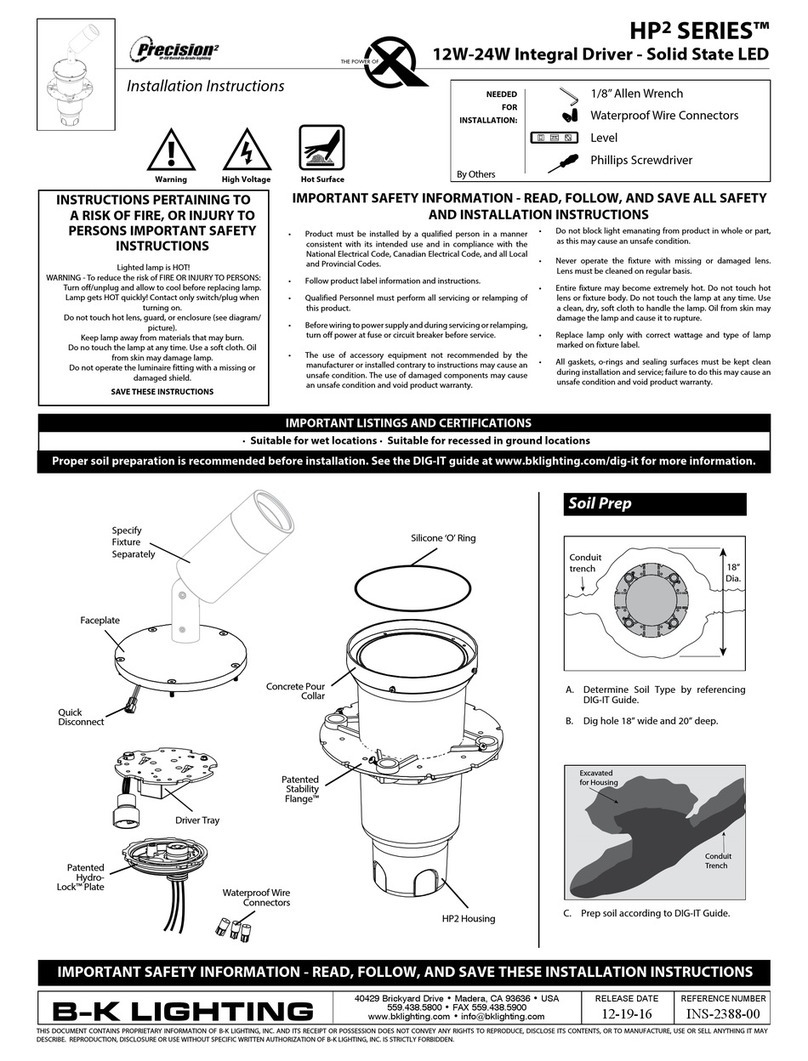
B-K lighting
B-K lighting HP2 SERIES installation instructions
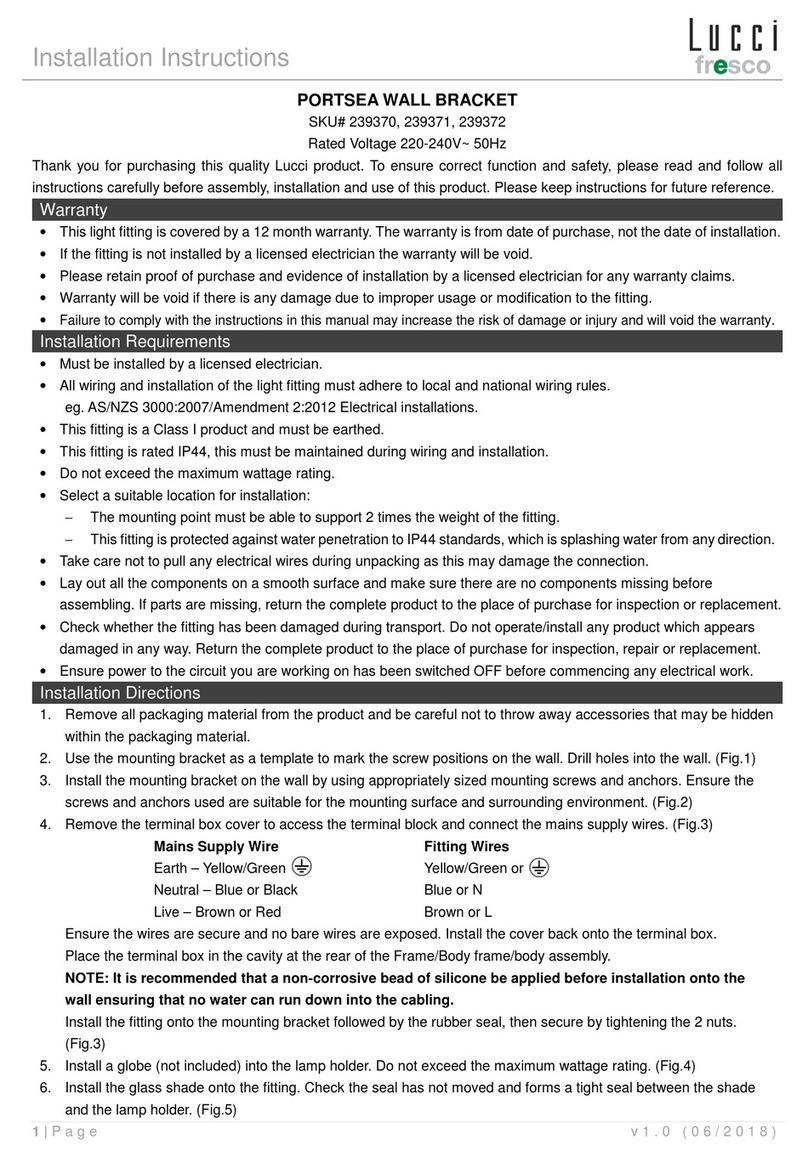
Lucci Fresco
Lucci Fresco PORTSEA WALL BRACKET installation instructions
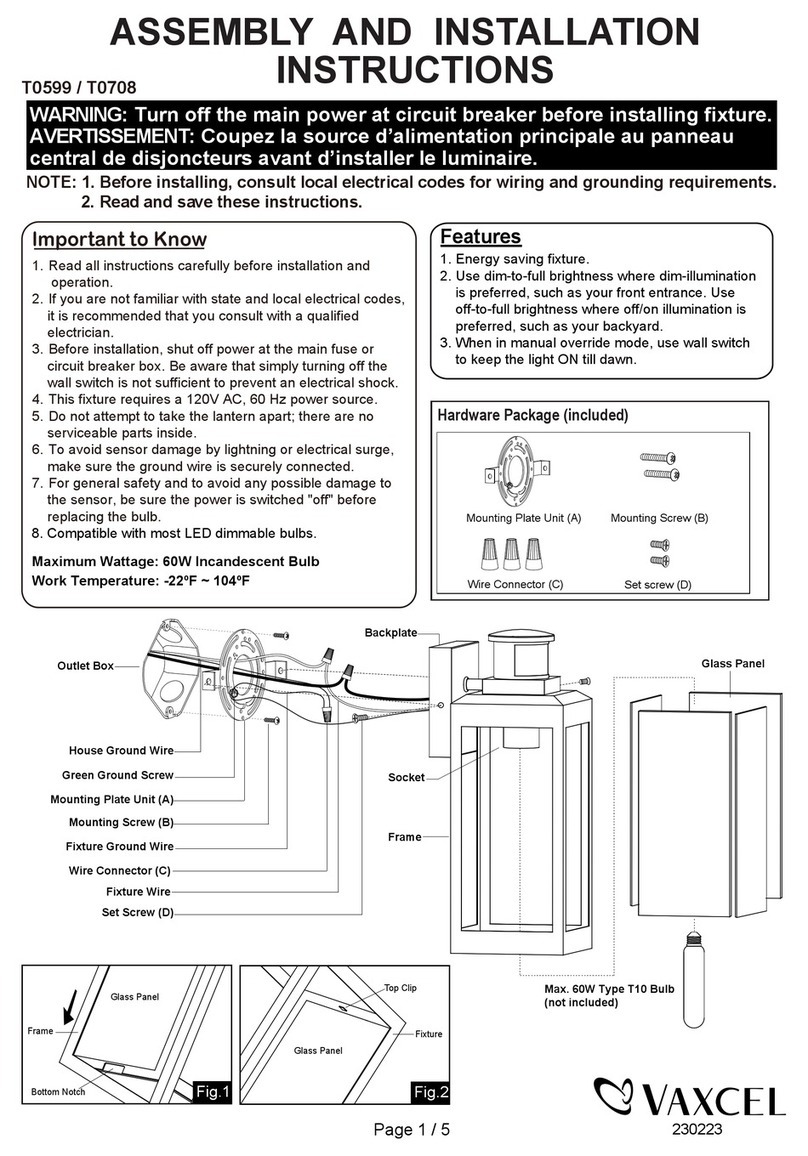
Vaxcel
Vaxcel T0599 Assembly and installation instructions
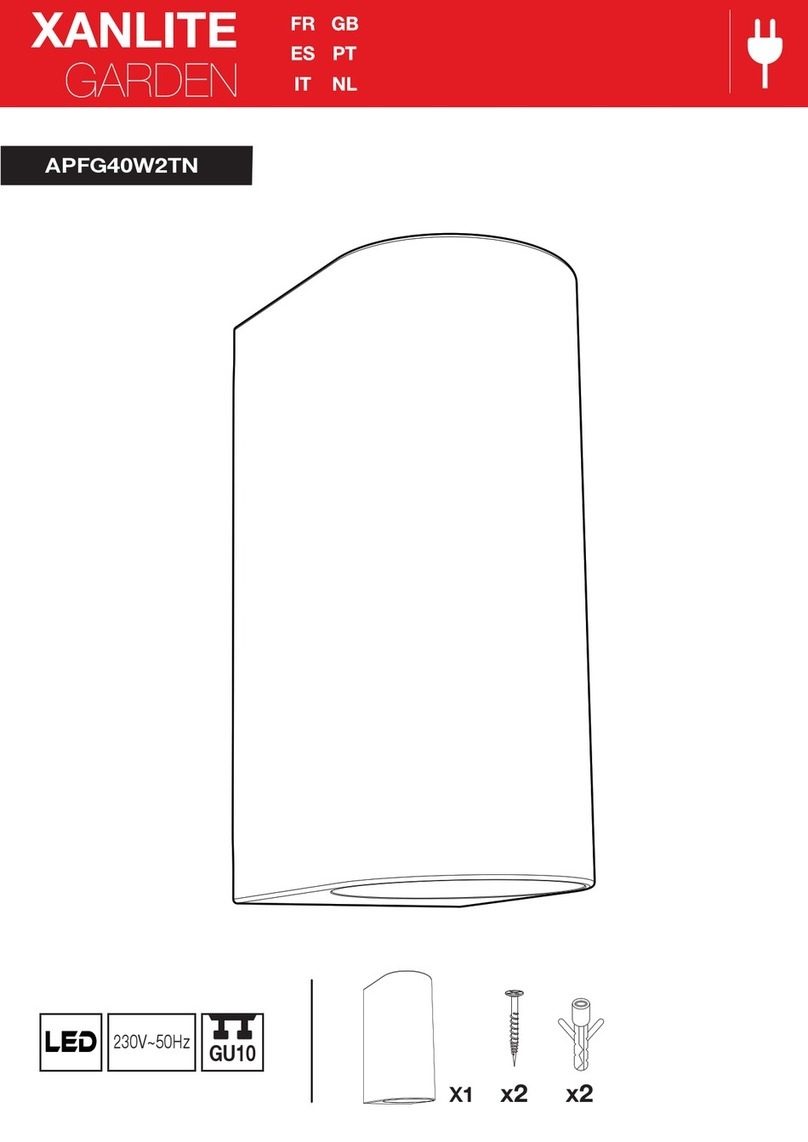
XanLite
XanLite Garden APFG40W2TN user manual

LIGMAN
LIGMAN JE-10571 installation manual
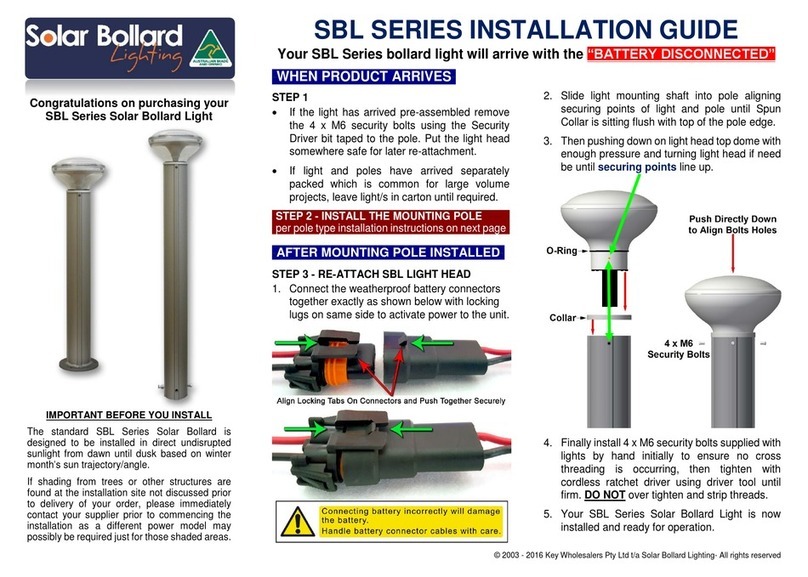
Solar Bollard Lighting
Solar Bollard Lighting SBL SERIES General installation guide

emaux
emaux E-Fusion operating manual

nordlux
nordlux CANTO KUBI 2 Mounting instruction
